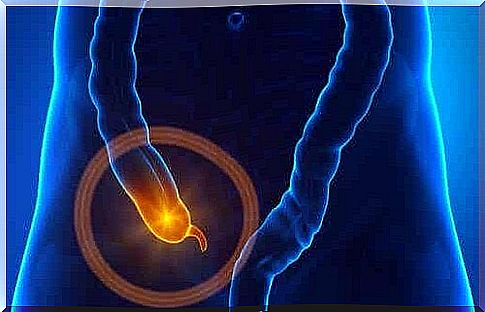Characteristics And Function Of The Cecum

There is a common notion that the cecum is just a remnant of human evolution and that it no longer serves any purpose. Indeed, the function of this small organ is still unclear to science. However, there is a lot of data showing that it may not be as useless as we previously thought.
Usually the appendix causes no problems until appendicitis develops. That is, when the bulge becomes inflamed and appendicitis occurs. We all know that in such cases a person has to undergo surgery to have the appendix removed.
About 8.6% of men will have to undergo an appendectomy or appendectomy. The figure is slightly lower for women: 6.67%. No one thinks they will miss this organ, but it’s not that simple.
What is the appendix?
The cecum is a small thin bulge of the large intestine, at a point called the cecum or cecum. It is located close to the small intestine. It is an extension of the ascending portion of the colon and is between 7 and 12 cm long.
The name worm-shaped appendage comes from its appearance, which resembles a worm. It is a kind of bag with an entrance but no exit. This is why food scraps can easily build up and become inflamed, causing appendicitis.
A change of perspective

Despite the prevailing ideas about this structure, researchers recently discovered that the cecum has evolved 26 times in mammals. That is, it has changed over the centuries to better fit the body. This fact did not correspond to the idea that it was of no use. Because if so, why were there so many adjustments?
A number of experts decided to join forces to investigate the reason for this apparent contradiction. For example, the initiative for a 2016 study sought to identify common factors in animals regarding the cecum. They analyzed hundreds of mammals, including humans.
The first conclusion they drew was that the cecum evolved more often than it disappeared. In other words, there were many more animals that maintained and modified this piece of gut than those where it disappeared. This fact led scientists on a surprising path.
New findings related to the cecum
The researchers also discovered that there is a high concentration of lymphatic tissue in the cecum and that this serves as a protection for the organism. This led them to hypothesize that the appendix might play an immunological role.
Physiologist Loren Martin of Oklahoma State University noted that the walls of the cecum, especially in children and young adults, contain many lymph cells.
As a result, that organ becomes a kind of tonsil of the gut, in his opinion comparable to the tonsils in the throat. This means that this little flap can be a front of defense against various diseases. Lymph cells could perform immune control.
One study seems to confirm this hypothesis, at least in part. According to the report, people infected with Clostridium difficile bacteria were twice as likely to become seriously ill if they no longer had a cecum.
Other interesting facts about the cecum
The above was not the only conclusion scientists drew. We now suspect that the cecum is also an important reservoir and refuge for the gut microbiota. In fact, this microbiota is the key to the immune system, metabolism and proper development of some organs.
It can change under various circumstances, such as severe diarrhea. What researchers suspect is that the cecum acts as a sort of emergency aid when that happens.
This means that it helps replenish the lost microorganisms. Apparently, under similar conditions, the recovery of the microbiota takes longer in people who have had appendectomy. As you have read, it seems that the appendix is not as useless as we thought.









